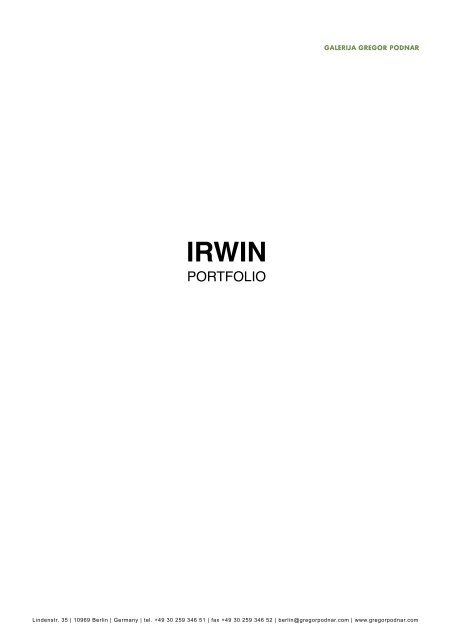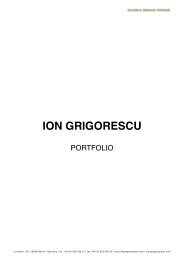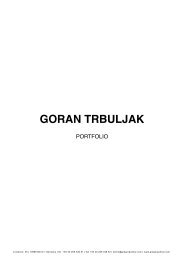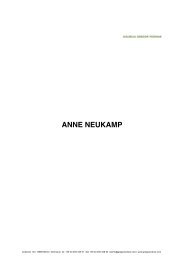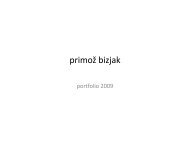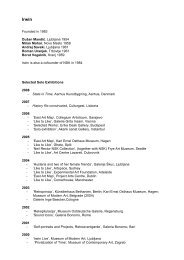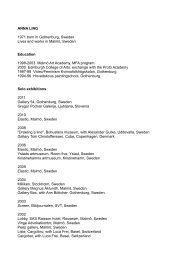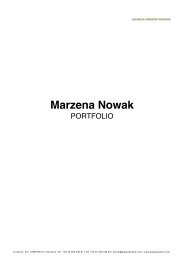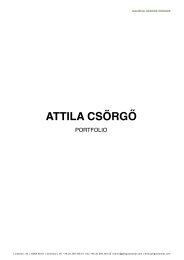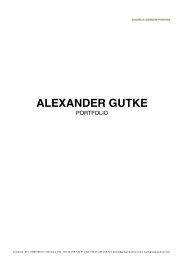irwin - Galerija Gregor Podnar.
irwin - Galerija Gregor Podnar.
irwin - Galerija Gregor Podnar.
You also want an ePaper? Increase the reach of your titles
YUMPU automatically turns print PDFs into web optimized ePapers that Google loves.
IRWIN<br />
PORTFOLIO<br />
Lindenstr. 35 | 10969 Berlin | Germany | tel. +49 30 259 346 51 | fax +49 30 259 346 52 | berlin@gregorpodnar.com | www.gregorpodnar.com<br />
!
Introduction<br />
IRWIN works in a complex and subtle way with connections between art and ideology. Their work brings<br />
together art historical references, such as Romanticism, Modernism or the Suprematism of Malevich, with<br />
symbols taken from religion or totalitarian political systems, for example from the Nazi era or from Soviet<br />
social realism. IRWIN has over time built a complex system of cross-references between their works and the<br />
works of other artists.<br />
The starting point for IRWIN is that different symbols have different meanings depending on place and time.<br />
In order to examine and discover the meaning and the function of a symbol IRWIN starts work according to a<br />
method or process they have developed themselves, the retro principle. This method means that in order to<br />
understand the meaning and function of a symbol one needs to investigate its origin. A reconstruction of the<br />
meaning of the symbol implies that the meaning of the symbol is changed retrospectively through the fact<br />
that IRWIN juxtaposes and appropriates the symbols into new contexts. Thereby the symbols are given new<br />
connotations. In many works IRWIN manifests the visual and ideological similarities between seemingly<br />
different totalitarian systems, the history of art and of religion. Their work often embraces a warm humor and<br />
in many of their works there are often marked ambiguities.<br />
IRWIN together with NSK (the artist collective Neue Slowenische Kunst, founded in 1984, where the music<br />
group Laibach is a member) can also be said to work with the question of the importance of culture when it<br />
comes to the reconstruction of a nation. In this work IRWIN takes as their starting point the Slovenian culture<br />
and the Slovenian nation. A nation that has to take into account the fact that it is situated, geographically as<br />
well as culturally, between East and West, between Central Europe and the Slavic heritage. Collectively the<br />
works of IRWIN deals with the European history of ideas and its ideological foundations, a political and<br />
cultural heritage that has shaped Europe in the past and will shape Europe in the future.<br />
Martin Schibli, on the occasion of the IRWIN-exhibition «What is art» at Kalmar Konstmuseum, Sweden, 2009<br />
!
Red Districts<br />
Blood, coal, oil on canvas, wood, marble, aluminium, gold, iron, glass, 350 x 420 x 40 cm, 1987<br />
Collaborators: Janez Knez, Tugo Susnik<br />
(second of two variants)<br />
!
Laibach State<br />
Wood, serigraphy on canvas covered with wax, silver leaves on wood, acrylic, tar; (Inside: aluminum cross,<br />
oil color, poster, mirror). Approx. 110 x 80 x 20 cm, 1987 (Dušan Mandič)<br />
!
Nova Acropola<br />
Wood, fur, serigraphy on wax paper, oil, plaster, 86 x 86 x 5,5 cm, 1988 (Roman Uranjek)<br />
!
IRWIN Icons<br />
Exhibition view at Venice Biennal 2003, 1993 -2003<br />
!
Cup of coffee I (Replica)<br />
Mixed media, 72 x 62 cm, 2003 (Andrej Savski)<br />
Vade Retro<br />
Mixed media, 93 x 69 cm, 1988 (Roman Uranjek)<br />
!
Bride (marvée)<br />
Mixed media, 86 x 60 x 16 cm, 2004 (Dušan Mandič)<br />
Malevich between two wars<br />
Mixed media, 77 x 51 cm, 1984-2001 (Dušan Mandič)<br />
!
Deer (Icon)<br />
Mixed media, 110 x 80 cm, 2003 (Miran Mohar)<br />
Wheel of the Wheels<br />
Wheel, chair, 140 x 55 x 55 cm, ed. of 4, 2000<br />
(Borut Vogelnik)<br />
!
Black Square on Red Square<br />
DVD, 3 min 15, Based on the action by Irwin and Michael Benson (footage of the Moscow TV and Kinteticon<br />
Pictures), edited by Igor Zupe, ed. of 3, 1992-1997<br />
On June 6, 1992 between 2 pm and 3 pm, the group Irwin and Michael Benson performed an artistic action<br />
Black Square on Red Square in collaboration with N. Abalakova (Tot-Art), D. Ariupin, M. Breznik, S. Bugayev<br />
(Africa), Charles, E. Cufer, B. Edelman, F. Fleck, J. Harten, J. Kollerova, V. Kesic, I. Koulik, E. and V.<br />
Kurlandzev, G. Kurierova, I. Smirnova, K. Tschouvaschew, K. Turchina and D. Zivadinov.<br />
The 30-minute action consisted of the spreading out of a 22 m x 22 m square made of black fabric in the<br />
central part of Red Square in Moscow.<br />
!
Transcentrala New York, Moscow, Ljubljana<br />
Cross (NY), Panorama (Ljubljana), Black Square on Red Square (Moscow)<br />
3 photographs, each 120 x 112 cm (framed), ed. of 4, 1992-1997<br />
Cross (1991), Black Square on Red Square (1992) and NSK Panorama (1997) are photographic documents<br />
of three actions by the artistsʼ collective Irwin, realized in New York, Moscow and Upper Carniola, and<br />
gathered together under the title Transcentrala. Three Suprematist symbols (cross, square and circle) were<br />
temporally installed in three sites with ideological implications. Following their method of “retro-principle”, the<br />
group re-contextualizes and deconstructs various motifs, symbols and signs from the field of art and politics.<br />
!
Exhibition view: Museum Ostdeutsche Galerie, Regensburg, 2002<br />
!
Corpse of Art<br />
Mixed media installation (acrylic resin on wood, clothes, wax, flowers), variable dimension , first of two<br />
versions, 2003-2004<br />
The installation Corpse of Art copies the circumstances of the laying out of Malevichʼs corpse in his Leningrad<br />
flat in May 1935: displaying it in the Suprematist coffin designed by his student, Nikolai Suetin, according to<br />
Malevichʼs own concept. IRWIN shows the Black Square alone above the coffin – and leaves out the two<br />
realistic images from Malevichʼs work, which flanked the Suprematist icon in the original arrangement. In this<br />
way, IRWIN simultaneously radicalises and undermines Malevichʼs totalitarian claim to mould not only his<br />
whole life but also his own death. As a symbol of the failure of his utopias of Suprematism, IRWIN erects a<br />
memorial to them at the same time and makes Malevichʼs displayed corpse into the medium of his universal<br />
ideas beyond his own death.<br />
(Extract from exhibitionʼs texts of Medium Religion, ZKM Center for Art and Media, Karlsruhe, 2008)<br />
!
Was ist Kunst (Frank Stella)<br />
C-print, plexiglas, aluminum, 161 x 231 cm, ed. of 3, 2002<br />
Photo: Klaus Vyhnalek<br />
«We donʼt consider ourselves as political artists, but rather we focus on how art itself is always political in<br />
certain contexts. We work on icons and stick on just a few «motifs» (subjects). In our paintings we are not<br />
interested in endorsing the idea of the supposed modernistic artistʼs freedom of choice in the subject. Real<br />
freedom for us lies in the idea of restriction.»<br />
IRWIN, festival THE INFLUENCERS, Barcelona, 2006<br />
!
Was ist Kunst (Tiflis)<br />
Ilfochrome, 109 x 146 cm, ed. of 3, 170 x 222 cm, ed. of 5, 2007<br />
Photo: Bojan Radovič<br />
In collaboration with Georgian Army<br />
Co-produced by TRAM foundation for One Stop project in the frame of Art Caucasus 2007<br />
!
Installation view at Cornerhouse, Manchester, 2004<br />
Like to Like<br />
100 x 118 x 6 cm (small size), ed. of 5, 2003-2004<br />
Photo: Tomaž <strong>Gregor</strong>ič<br />
!
Like to Like / the constellation of candles in the field corresponding to the constellation of the stars in<br />
the sky<br />
Photo reconstruction of the group OHO – action: The constellation of candles in the field corresponding to the<br />
constellation of the stars in the sky 1970 (Milenko Matanović), ed. of 5, 2004<br />
!
Like to Like/ Mount Triglav<br />
Photographic reconstruction of the group OHO – action: Mount Triglav from 1970 (Milenko Matanović, David<br />
Nez, Drago Dellabernardina), ed. of 5, 2004<br />
!
Like to Like / Wheat and Rope<br />
Photo reconstruction of the group OHO – action<br />
Wheat and Rope from 1969, ed.of 5, 2003 (Milenko<br />
Matanović)<br />
Irwinʼs project called Like to Like (2003-2004) consists of six large-scale color photographs presenting actions<br />
and projects in landscape. For anyone familiar with Slovene art after 1945, the images are easily<br />
recognizable as projects of the group OHO.<br />
Like to Like / water-air<br />
Photo reconstruction of the group OHO – action<br />
Family of fire, air and water: water-air from 1969, ed.<br />
of 5, 2004 (Marko Pogačnik)<br />
OHO was the most important Slovene neo-avant-garde group of the 60s and early 70s. The word itself is a<br />
combination of oko (eye) and uho (ear) and is, at the same time, an expression of astonishment. Roughly,<br />
OHOʼs activity could be divided into three main periods. In the first period (1969 – 1968), it functioned as a<br />
multi- and inter-media movement (objects, drawings, film, books, actions, visual poetry, music, etc.) with a<br />
broad range of members and collaborators. In the second period, OHO (1969 – 1970) was organized as an<br />
art group, and its activities included contemporary and avant-garde art forms, from arte povera and process<br />
art to land art, performance, body art, and conceptual art. In the last period (1970 – 1971), OHO was<br />
transformed into a community and developed a specific type of conceptual art which aimed at establishing a<br />
spiritual communication and ties between the members of the group and between the group and the world. In<br />
1971, OHO – on the threshold of international success – decided to abandon art as a separate field and try<br />
to find a synthesis of art and life by establishing a community in the village of Šempas.<br />
Irwin re-staged six of OHO projects (originally carried out between 1968 and 1970) that all belong to the most<br />
representative and best known OHO works. They appropriated OHOʼs projects not by using the original<br />
photographs, but by re-staging original actions and by reproducing them on large-scale, perfectly executed<br />
color photographs. This difference is strikingly accentuated by the use of the spectacular possibilities of<br />
contemporary photography. The OHO artist (just as a number of other artists from that period) were never too<br />
interested in producing lasting art objects. Their actions were ephemeral and often carried out without<br />
audience. IRWIN transformed the compositions of the images (originally unimportant and accidental) into<br />
recognizable art icons.<br />
!
Like to Like / Night, bow, burning arrows<br />
Photo reconstruction of the group OHO – action Night,<br />
bow,burning arrows from 1970, ed. of 5, 2004 (Andraž<br />
Šalamun)<br />
What they present, therefore, are not just OHO actions, but OHO as a phenomenon that already belongs to<br />
the history of art and culture. OHO became such a phenomenon also through the process that placed the<br />
documentary images on the position of works of art. This operation can be understood as a symptom of a<br />
more fundamental operation, i.e. of codification and categorization of OHO. But they also point at the<br />
relativity and instability of their meaning. With the change of the context, the same image, symbol, or form<br />
can obtain very different connotations...<br />
Dealing with OHO, Irwin also deal with themselves and their own practices and ideas. Some of these projects<br />
deal with the idea of the collective artistic production, even a collective artistic body. Even those OHO<br />
projects that could be described as works of process art use the model of “family” to describe relations based<br />
on differences, sometimes oppositions or even conflicts, that result in a flexible, dynamic unity.<br />
In his story “Pierre Menard, Author of the Quixote”, Borges described a late 19th century French writer whose<br />
central work consists of rewriting parts of Cervantesʼ novel. “He did not want to compose another Quixote –<br />
which is easy – but the Quixote itself,” writes Borges. “Needless to say, he never contemplated a mechanical<br />
transcription of the original; he did not propose to copy it. His admirable intention was to produce a few<br />
pages which would coincide – word for word and line for line – with those of Miguel de Cervantes.” When<br />
Irwin re-stage OHO projects, these get a whole new set of references. The wheat field, for example, becomes<br />
a reference to the Irwinʼs recurring motif of the sower. The actions dealing with the collective identity become<br />
references to Irwinʼs collective artistic practice. Re-staging of OHOʼs Triglav project refers to numerous<br />
Irwinʼs works that deal with images of mountains, and particularly to their interest in the ideological content of<br />
the image of mount Triglav that is Slovene national symbol. As Borges says: “Menard (perhaps without<br />
wanting to) has enriched, by means of a new technique, the halting and rudimentary art of reading: this new<br />
technique is that of the deliberate anachronism and the erroneous attribution.<br />
Extract from Like to Like by Igor Zabel, Ljubljana, September 2004<br />
Like to Like / OHO<br />
Photo reconstruction of the group OHO – action<br />
from 1970, ed. of 5, 2004<br />
!
Namepickers<br />
C-Print, 109 x 97 cm, ed. of 5, 1998 (In cooperation with: Marina Abramovic)<br />
Photo: Bojan Brecelj<br />
In a straightforward and simple way – and with an elegant allusion to prostitution – Namepickers points out<br />
that the essence of the artwork is determined by the authorʼs name. Namely, rating of the artistʼs name<br />
affects the market value of the work, and, retroactively, also his identity, which is perceptively – ironically –<br />
completely identical in any case. Thus IRWIN is facing the perfidious logic of a market also capable of<br />
capitalizing the speculative values of the author, even when these prove to be practically indefinable.<br />
!
IRWIN Live<br />
Installation/performance at CCA, Warsaw, 1998 (Guest artist: Zbigniew Libera)<br />
IRWINʼs paintings are hanged on the ceiling, the members of the group are suspended underneath and<br />
discuss about their works.<br />
!
Golden Smile<br />
C-print, 130 x 80 cm, ed. of 5, 2003<br />
Photo: Tomaž <strong>Gregor</strong>ič<br />
!
DA+DA<br />
Video, duration 3ʼ51ʼ, 2010<br />
Bischop M. Zlatanov reciting poems written for H. Ball, Cabaret Voltaire, Zurich 20.4.2010<br />
!
Dreams and Conflicts<br />
ca 170 x 260 cm, ed. of 3, 2003<br />
Photo: Igor Andjelič<br />
In order to create the photograph Dreams and Conflicts, the group Irwin stayed overnight at the Venice train<br />
station during the 50th Venice Biennial (2003). Their goal was to repeat a situation they had first experienced<br />
in 1986 when the group unofficially exhibited parallel to the 42nd Biennial (1986) and had been sleeping at<br />
the train station.<br />
!
The NSK State in Time<br />
(NSK Embassy Moscow, May 10- 12, 1992)<br />
The NSK (Neue Slowenische Kunst or New Slovenian Art) collective has a multiform history. In the early<br />
1980s the fine art group Irwin, together with the music group Laibach, a theatre group Sester.<br />
»The NSK State in Time« was established in the only way possible, as a virtual entity that had no real<br />
territory (as it was said that it was precisely because of territorial concerns that we were witnessing the<br />
Balkan war) but only the insignias of a real State – passports, flag, etc., – which were elaborated as<br />
artefacts. From time to time, however, the »NSK State in Time« was displayed in real space. In the 1990s the<br />
NSK State in Timeʼs Embassies and Consulates were inaugurated in private apartments and houses, hotel<br />
rooms, and similar places to question the politics of space within/outside the Balkans/Europe and the Art<br />
Institution. The group Irwin established the NSK Embassy in Moscow in a private apartment (address:<br />
Leninsky Prospect 12, apt. 24) in May and June 1992. The facade of this residential dwelling was<br />
embellished with the artistically articulated insignia of a state embassy. Spaces that had always been<br />
considered as being outside the matrix of art and culture or at the margins of the system were suddenly<br />
transposed into the centre of the art system. NSK Consulates were opened in Florence, Italy (1993), at the<br />
Hotel Ambasciatori, and in Umag, Croatia (1994), in the kitchen of Marino Cettina, the Dante Gallery ownerʼs<br />
private apartment.<br />
The virtual NSK State tackles ambiguous procedures of codification and the system rules and principles that<br />
serve to define historical coincidence and artificiality. This parallelism between art and the state poses radical<br />
questions about the procedures and instructions that are at the base of the formation of the art system and<br />
which are crucial for its reproduction. »The NSK State in Time« displayed an incredible discontinuity and<br />
provoked an intensive public questioning in time and within time. In an attempt to emphasize the synthetic<br />
dialectical moment developed in »The NSK State in Time«, I asked myself in the mid-1990s how we could<br />
label this spiritual element of corporeality (the State in Time) and this corporeal element of spirituality<br />
(embassies and consulates in concrete private spaces). I proposed that we define them as spectres.<br />
!
NSK Citizens from Nigeria NSK-Logo<br />
2007<br />
Filmed in London from May 5-7, 2007 by film maker and visual anthropologist Esben Hansen<br />
(collaborator: Julie Boticello, anthropologist)<br />
Duration: approximate 80 minutes (non-edited material) ens Sarajevo 2007<br />
I stated, re-elaborating Jacques Derridaʼs The Spectres of Marx, that »The NSK State in Time« is the spectre<br />
of the state; NSK Embassies are spectres of embassies. »The NSK State in Time« was a transposition, as<br />
much as it was also a spectralization of the evacuation of specific historical, social and political spaces of<br />
former Eastern Europe, of its present non-existing condition. Or it is possible to say that precisely because<br />
NSK comes from a territory that is today described as “ex” or “former”, hence firmly grounded in time, NSKʼs<br />
projects imply the re-constitution of its historical, art and cultural space through time. This is why NSKʼs<br />
projects are so intricately involved in re-reading history, in the temporalization and spatialization of culture,<br />
art and the social. With two symbols or indicators – the NSK cross originated within the artistic legacy of<br />
Kasimir Malevich and the Nazi swastika – the virtual NSK State creates terrifying constructions and<br />
narratives deeply rooted in politics.<br />
Irwin reused the cross from Malevichʼs paintings, but emptied it of any spiritual meaning. It is possible to<br />
explain this trajectory as being similar to what Heartfield did with the process of montage. There is something<br />
paradoxical about this virtual state model and its possible (kitschy, That they are like an army is emphasized<br />
by their uniform style of sober suits and ties. Behind their uniform they hide their role of maximizing the<br />
efficiency of the capitalist machine. Through their mode of dress and in the way they function, they are a<br />
normalized anomaly within the capitalist system in Japan. The effect of such juxtapositions is the<br />
derealisation and the de-psychologisation of the reality of the Institution of Contemporary Art. This is politics<br />
beyond simple dichotomies reusing the concept of the de-realisation [and depsychologisation] of art<br />
(although we should be aware that the abstract positioning of art in contemporary capitalism insists on the<br />
psychological moment and on the psychology of the individual artist). Juxtapositions like this result in a<br />
diffracted picture of reality between art and army.<br />
Irwin does not ask us to merely choose between two or more options within a set of coordinates (art vs. army,<br />
etc.), but to change the set of coordinates itself. What we have to deal with here is the traumatic real, the re-<br />
articulation and re-questioning of the position of the army in contemporary societies and art within the art<br />
institution.<br />
Irwin: NSK Guards by Marina Gržinić; Published in Camera Austria, Graz , no. 96/2006.<br />
!
NSK Garda<br />
10 Iris Prints in Plexiglas boxes, from 1998 until 2007<br />
100 x 140 cm; ed. of 3 + AP<br />
50 x 70 cm; ed. of 5 + AP<br />
NSK Garda is a project by group Irwin that started in 1998 in Tirana, Albania (NSK Guard Tirana) and was<br />
later followed by identical realizations in Prague, Zagreb, Rome, Cetinje, Graz, Kyoto, Pristhina, Biskek and<br />
Sarajevo.<br />
All of the projects were organized through the cooperation between local art institutions and army<br />
headquarters. The basic action is very simple: 4 soldiers are guarding the NSK flag, they have crosses on<br />
the armbands and theyʼre standing there for one or two hours. The location is important; it has to be a public<br />
place, square, etc. and is usually linked to the place where we exhibit.<br />
Formally we see this project as some sort of tableau vivant of the real army wearing our and Malevich cross -<br />
art society and army society are social structures that are usually on the opposite ends of the social<br />
spectrum and very rarely mixed. As an art state NSK is in fact in some sort of parasitic relation with other,<br />
normal states and in this project this is made visible.<br />
!
NSK Garda Tirana<br />
In collaboration with Albanian Army<br />
National Gallery, 21. 12. 1998<br />
Ed. of 6<br />
NSK Garda Graz<br />
In collaboration with Austrian Army<br />
Forum Stadtpark, 6. 10. 2001<br />
Iris print, 140 x 100 cm<br />
Photo: Wolfgang Croce<br />
Ed. of 6<br />
NSK Garda Zagreb<br />
In collaboration with Croatian Army<br />
Museum of Contemporary Art, 10. 12.2000<br />
Photo: Igor Andjelič<br />
Ed. of 6<br />
NSK Garda Tbilisi<br />
In collaboration with Georgian Army<br />
TRAM (Transform Art Module) Foundation,<br />
13. 10. 2007. Photo: Bojan Radovič<br />
Ed. of 6<br />
NSK Garda Prague<br />
In collaboration with Czech Army<br />
MXM Gallery, 15. 9. 2000<br />
Photo: Igor Andjelič<br />
Ed. of 6<br />
NSK Garda Biskek<br />
In collaboration with Kyrgyz Army<br />
Kurama Art Gallery, 25. 4. 2004<br />
Photo: Erkin Boljurov<br />
Ed. of 6<br />
!
Retroavantgarde<br />
Mixed media (collage, acrylic on paper), 120 x 200 cm, 1st version, 1996<br />
The Retro-avantgarde project<br />
All «isms» in art were coming from the west, while for us every «ism» was a product of fiction and we<br />
managed to create our own: retro-avangarde. Somehow in the East the art system was lacking some of the<br />
elements it had in the western society. So it was not a matter of opposing to something or reclaiming our own<br />
space, but to build reality. Our condition was to construct our own condition.<br />
IRWIN, festival THE INFLUENCERS, Barcelona, 2006<br />
!
East Art Map<br />
The aim of East Art Map is to show the art of the whole space of Eastern Europe, to take artists out of their<br />
national frameworks and to present them in a unified scheme. IRWIN would like to display the practical<br />
fundamental relations between Eastern European artists there where they have not been documented, to<br />
draw a sort of a clear and user-friendly map of the art of Eastern Europe rather than to get some theoretical<br />
true thereof. History is not given. It has to be constructed.<br />
The group worked over East Art Map project (www.eastartmap.org) from 1999 to 2005. The project is a sort<br />
of a guidebook through the contemporary art of Eastern Europe and its relations with Western arts, social<br />
and political history. Initially, Irwin invited a group of 24 eminent art critics, curators and artists from the<br />
different ex-socialist Central, Eastern and South-Eastern countries to perform and to show 250 crucial art<br />
projects and artworks from their respective countries. Upon the results thereof, in 2006, it published the<br />
project book. The next step, technically as well as conceptually, was to transfer the EAM onto Internet and to<br />
open it up for contributions by its users, the general public and specialists being invited to participate in<br />
discussion, which may, for sure, change the topography of the map.<br />
!
Monochromes<br />
With the exhibition Monochromes, the group only appears to be moving away from visible references to<br />
artistic and political ideologies; in fact, the referencing of “pure,” abstract art is, above all, a commentary on<br />
the history of modernism with all its disjunctures and conflictual potential, as well as, of course, a way of<br />
receiving modernist principles, and Irwinʼs own recent history, in the present time.<br />
From the perspective of art history, monochromatic painting has appeared in a variety of different contexts in<br />
modernism. The common element was the treatment of images as the objects of an understanding in which<br />
painting was most often viewed as research into optical and psychophysical phenomena. Monochromism<br />
appears in the first decade of the twentieth century in the works of Kazimir Malevich and Aleksandr<br />
Rodchenko as the negation of the aesthetic understanding of painting; later, it appears, in less radical but no<br />
less spiritualized forms, in the work of Yves Klein, not to mention the broader tradition of abstract painting<br />
from Piet Mondrian, Josef Albers, and Ad Reinhardt to Frank Stella and Barnett Newman and other European<br />
and American abstractionists.<br />
Press release of the exhibition Monochromes, 2008 at <strong>Galerija</strong> <strong>Gregor</strong> <strong>Podnar</strong>, Berlin<br />
!
Dada magazine 4-5, (1918)<br />
Paper, siver leafs, cloth, bitumen, plaster, 40 x 31 x 6 cm, 2010<br />
!
Multiple Hugo Ball (4/4)<br />
Mixed media, ed. of 5 + AP, 79 x 59 x 6 cm, 2010<br />
!
Yellow Monochrome<br />
Lego bricks, wood, fabric, 91 x 71 x 6 cm, 2007 (Miran Mohar)<br />
!
Green Monochrome- Sower<br />
Oil on canvas, 77,5 x 87 cm, 2007 (Andrej Savski)<br />
!
From Light to Darkness<br />
Wood, silver leaves, epoxy, 85 x 59 x 9 cm, 2007 (Dušan Mandič)<br />
!
Monochrome – green<br />
Painting on wood, plaster, Plexiglas box (covered with a<br />
lenticular screen), 91 x 72 cm, 2008 (Andrej Savski)<br />
Irwin-Monochrome. Icon Deer III<br />
Acrylic on canvas, 60 x 60 cm, 2008 (Roman Uranjek)<br />
Monochrome – Yellow<br />
Oil on panel, 40 x 29,5 x 5,5 cm, 2007 (Borut Vogelnik)<br />
!
Irwin – Copper Monochrome<br />
Print, copper, 150 x 100 cm, 2008 (Roman Uranjek)<br />
Irwin-Monochrome. Icon Cross<br />
Acrylic on canvas, 150 x 100 cm, 2008 (Roman Uranjek)<br />
Grey Monochrome (3D)<br />
Lenticular screen, silver leaves, cloth, 89 x 69 x 6 cm, 2007<br />
!
Irwin Monochrome – I.K.Blue<br />
Pigment, aluminum, 76 x 51 x 5,5 cm, 2008 (Roman Uranjek)<br />
Monochrome<br />
Bischop Metodij Zlatanov of Macedonian<br />
orthodox church, holding an Irwin<br />
Monochrome: Pure red color (dedicated<br />
to A.Rodschenko, 1921)<br />
Iris print, wood, canvas, 109 x 79 cm, 2008<br />
(Dušan Mandič)<br />
Watercolour on Iris print, 72 x 93 cm, 2007 (Borut Voglenik)<br />
!
IRWIN<br />
Founded in 1983<br />
Dušan Mandič, Ljubljana 1954<br />
Miran Mohar, Novo Mesto 1958<br />
Andrej Savski, Ljubljana 1961<br />
Roman Uranjek, Trbovlje 1961<br />
Borut Vogelnik, Kranj 1959<br />
Irwin is also a cofounder of NSK in 1984<br />
Selected solo exhibitions<br />
2012<br />
NSK Passport Office, MoMA, New York, USA<br />
Was ist Kunst Hugo Ball, Elaine Levy Project, Bruxelles, Belgium<br />
2011<br />
Was ist Kunst Hugo Ball, <strong>Galerija</strong> <strong>Gregor</strong> <strong>Podnar</strong>, Ljubljana, Slovenia<br />
NSK Passport Holders, Acik Ekran New Media Center, Instanbul, Turkey<br />
NSK Folk Art, SKUC Gallery, Ljubljana, Slovenia<br />
East Art Map, Atelje Dado, Cetinje, Montenegro<br />
2010<br />
First NSK Citizens Congress, Haus der Kulturen der Welt, Berlin, Germany<br />
State in Time, Dolenjski museum, Novo Mesto, Slovenia<br />
Cabaret Voltaire, Zürich, Switzerland<br />
The Israeli Center for Digital Art, Holon, Israel<br />
NSK Passport Holders, Center for contemporary art, Lagos<br />
2009<br />
NSK Passport Holders, Moderna <strong>Galerija</strong>/T5. Ljubljana, Slovenia<br />
NSK Passport Holders, Tri Postal, Lille, France<br />
Was ist Kunst, Kalmar Konstmuseum, Kalmar, Sweden<br />
State in Time, Kunsthalle Krems, Austria<br />
Paintings and Photographies, Galerie Grita Insam, Vienna, Austria<br />
2008<br />
Monochromes, <strong>Galerija</strong> <strong>Gregor</strong> <strong>Podnar</strong>, Berlin, Germany<br />
Black Square on the Red Square, The Crouch - Art Basement Project if the Institute of Contemporary Art, Sofia,<br />
Bulgaria<br />
State in Time, Aarhus Kunstbygning, Aarhus, Denmark<br />
East Art Map, Pinchuk Foundation, Kiev, Ukraine<br />
2007<br />
History Re-constructed, Culturgest, Lisbon, Portugal<br />
2006<br />
East Art Map, Collegium Artisticum, Sarajevo, Bosnia and Herzegovina<br />
Like to Like, Galerie Grita Insam, Vienna, Austria<br />
Selected Works, Erika Deak Gallery, Budapest, Hungary<br />
Akank sanat Gallery, Instanbul, Turkey<br />
2005<br />
!
East Art Map, Karl Ernst Osthaus Museum, Hagen, Germany<br />
Like to Like, Gheto, Split, Croatia<br />
Neil Rector NSK Collection, (together with NSK) Frye Art Museum, Seattle, USA<br />
Like to Like, Art Centre Lazareti, Dubrovnik, Croatia<br />
2004<br />
Hysteria and two of her female friends, <strong>Galerija</strong> Škuc, Ljubljana<br />
Like to Like, Artspace, Sydney, Australia<br />
Like to Like, Experimental Art Foundation, Adelaide, Australia<br />
East Art Map, Project Arts Centre, Dublin, Ireland<br />
Like to Like, Cornerhouse, Manchester, UK<br />
2003<br />
Retroprincip, Künstlerhaus Bethanien, Berlin; Karl Ernst Osthaus Museum, Hagen; Museum of Modern Art,<br />
Belgrade, Serbian<br />
Galerie Inge Baecker,Cologne, Germany<br />
2002<br />
Rekapitulacija, Museum Ostdeutsche Galerie, Regensburg, Germany<br />
Sound Icons, Galeria Bonomo, Rome, Italy<br />
2001<br />
Self-portraits and Projects, Retroavantgarde, Galeria Bonomo, Bari, Italy<br />
2000<br />
Irwin Live, Museum of Modern Art, Ljubljana, Slovenia<br />
Privatization of Time, Museum of Contemporary Art, Zagreb, Croatia<br />
Interiors of the Planit, Ursula Noordung, Retroavantgarde, Galerie Rabouan Moussion, Paris, France<br />
1998<br />
Three Projects, ICA Ujazdowski Castle, Warsaw, Poland<br />
Transnacionala Vienna, Galerie Grita Insam, Vienna, Austria<br />
1997<br />
Interior of the Planit, Tramway, Glasgow, UK<br />
Transnacionala Barcelona, Sala Montcada de la Fundacio La Caixa, Barcelona, Spain<br />
1996<br />
Transnacionala (conceptualized journey from East to the West Coast), project "Conversation at the Castle",<br />
Atlanta, USA<br />
Interior of the Planit, Ludwig Museum Budapest, Budapest, Hungary<br />
1995<br />
The Interiors of the Planit, Anonimus Gallery, Ljubljana, Slovenia<br />
Project Proposal for the NSK Embassy in Beijing, Galerie Bleich-Rossi, Graz, Austria<br />
1994<br />
Project Proposal for the NSK Embassy in Beijing, Galerie Inge Baecker, Cologne, Germany<br />
NSK Konzulat Umag, <strong>Galerija</strong> Dante, Umag, Slovenia<br />
1993<br />
Irwin-NSK Embassy Moscow Interior, Center on Contemporary Art, Seattle, USA<br />
Transcentrala, Old Poverplant, Ljubljana, Slovenia<br />
1992<br />
La Geografia del Tempo, Galleria Carini, Florence, Italy<br />
NSK Embassy – Moscow, Apt Art and Ridzina Gallery, Moscow, Russia<br />
1991<br />
!
Kapital, Pittsburgh Center for the Arts - National Gallery, Pittsburgh; New Langton Arts, San Francisco, The Institute<br />
for Contemporary Arts, Clocktower Gallery, New York; District of Columbia Arts Centre, Washington D.C.USA<br />
1990<br />
Kapital, <strong>Galerija</strong> Equrna, Ljubljana, Slovenia<br />
Selected group exhibitions<br />
2012<br />
One Sixt of the Earth. Ecologies of image, MUSAC, Castilla y Leon, Spain<br />
The Present and Presence, Musuem of Contemporary Art Metelkova, Ljubljana, Slovenia<br />
2011<br />
Night of Museums and Galleries, Plovdiv, Bulgaria<br />
The Global Contemporary. The Art Worlds after 1989. ZKM, Center for Art and Media, Karlsruhe Germany<br />
Dada Moscow, Artplay Design Center, Moscow, Russia<br />
Ensayos de geopoetica, Mercosur Biennal, Porto Alegre, Brasil<br />
Impossible Community, The State Museum of Contemporary Art of the Russian Academy of Arts, Russia<br />
A Slodown at the Museum, Extra City, Kunsthalle Antwerpen, Germany<br />
The international. MACBA, Museum of contemporary Art, Barcelona, Spain<br />
European Triennial of Small Sculpture. <strong>Galerija</strong> Murska Sobota, Slovenia<br />
Il corpo metafora di unʼesperienza. CIAC, Centro Italiano Arte Contemporanea, Foligno, Italy<br />
2010<br />
Things evoke feelings, CSW Center for Contemporary Art Ujazdowski Castle, Warsaw, Poland<br />
Taipei Biennial 2010, Taiwan<br />
Wealth of Nations, Spike Island, Bristol, United Kingdom<br />
The Promises of the Past. A discontinuous history of art in Eastern Europe, Pompidou Centre, Paris<br />
Heimtat Donovina, Museum Moderner Kunst Kärnten, Klagenfurt, Austria<br />
Quartet–Four Biennials Reflected in Prints, International Centre of Graphic Arts (MGLC), Ljubljana. Curated by<br />
René Block, Berlin, Germany<br />
2009<br />
La Fondazione Cassa di Risparmio di Modena, Italy<br />
3rd Moscow Biennial for Contemporary Art at Red October Chocolate Factory, Moscow, Russia<br />
Modernologies, MACBA, Barcelona, Spain, traveling to Museum of Modern Art, Warsaw, Poland<br />
A pair of Left Shoes, Bochum Musem, Germay. Travel to: Museum of Contemporary Art of Zagreb, Croatia<br />
Utopics, 11e Exposition Suisse de Sculpture, Biel, Switzerland<br />
RE:akt! Reconstruction, Re-enactment, Re-reporting MNAC, Bucharest. Travel to:<br />
SKUC gallery, Ljubljana, and Museum of Modern and Contemporary Art, Rijeka<br />
Europe XXL, Tripostal, Lille, France<br />
2008<br />
1st Brussels Biennial for contemporary art, Brussels, Belgium<br />
Taipei Biennial, The Taipei Art Museum, Taiwan<br />
Medium Religion, ZKM, Karlsruhe, Germany<br />
Here is Every, Four Decades of Contemporary Art, MoMA, New York, USA<br />
Signs of Change; Social Movement Cultures 1960s to Now, Exit Art, New York, USA<br />
The Renaming Machine, P74 Center and Gallery, Ljubljana, Slovenia<br />
Kontakt… Works from the Art Collection of Erste Bank Group, Institute of Contemporary Art – Dunaujvaros,<br />
Hungary<br />
Genau+Anders – Mathematik in der Kunst von Dürer bis Sol LeWitt, MUMOK, Vienna, Austria<br />
Less is less and more is more, that´all, CAPC Musée d´Art Contemporain, Bordeaux, France<br />
The Art World, Unit 40, London, UK<br />
2007<br />
Erste Bank Collection, MoCAB Museum of Contemporary Art, Belgrad, Serbian<br />
Not-quite/Not-right, <strong>Galerija</strong> Herman Pečarič, Piran, Slovenia<br />
!
Grow Your Own, Palais de Tokyo, Paris, France<br />
Das Schwarze Quadrat. Hommage an Malewitsch, Hamburger Kunsthalle, Hamburg, Germany<br />
Not-quite/Not-right, Foto galerija, Ljubljana, Slovenia<br />
Not-quite/Not-right, Pilonova galerija, Ajdovščina, Slovenia<br />
Locally Localized Gravity, ICA Philadelphia, Philadelphia, USA<br />
One Stop, Tram, Tbilisi, Georgia<br />
2006<br />
Eye on Europe, MOMA, Museum of Modern Art, New York (cat.), USA<br />
Kontakt … works from the Collection of Erste Bank Group, MUMOK, Museum Moderner Kunst Stiftung Ludwig,<br />
Vienna (cat.), Austria<br />
Normalisation, Rooseum Center for Contemporary Art, Malmö, Sweden<br />
The Sun on the Wall, Arsenals, (Trajectory series, LCCA), Riga, Latvia<br />
Essence of Life Art, The State Russian Museum, St. Petersburg, Russia<br />
Interrupted Histories, Moderna galerija, Ljubljana, Slovenia<br />
On Difference 2, Stuttgart Kunstverein, Stuttgart, Germany<br />
Political Realities, Heidelberger Kunstverein, Heidelberg, Germany<br />
2005<br />
Collective Creativity, Fridricianum, Kassel, Germany<br />
7th Sharjah biennial, Sharjah, United Arab Emirates<br />
Istanbul Biennial, Istanbul, Turkey<br />
Politike Slikarstva, Cankarjev dom, Ljubljana, Slovenia<br />
2004<br />
Berlin – Moscow / Mocsow – Berlin, Historical Museum, Moscow, Russia<br />
Venture, <strong>Galerija</strong> <strong>Gregor</strong> <strong>Podnar</strong>, Kranj, Slovenia<br />
EV+A Biennial, Limerick, Ireland<br />
…and Others, Kyrgyz National Museum of Fine Art / Kurama Art Gallery, Bishkek, Kyrgystan<br />
The Post_Communist Condition, Kunst-Werke, Berlin, Germany<br />
The beauty of failure / The failure of beauty, Joan Miró Foundation, Barcelona, Spain<br />
Lodz Biennial, Warshaw, Poland<br />
Il Buon Governo dellArte, Modern and Contemporary Art City Museum, Bergamo, Italy<br />
2003<br />
Individual Systems, Biennial of Venice, Venice, Italy<br />
2002<br />
Museotopia, Karl Ernst Osthaus Museum, Hagen, Germany<br />
(Un)painted, Essel Museum, Vienna, Austria<br />
State Museum of Contemporary Art, Thessaloniki, Greece<br />
2001<br />
U3, Vulgata, Museum of Modern Art Ljubljana, Slovenia<br />
Artisti Asuonati, Flash Art Museum, Trevi, Italy<br />
Europa 2000, Palazzo della triennale, Milano, Italy<br />
Le Tribu delarte, Galeria Moderna e Contemporanea, Rome, Italy<br />
Oko in njegova resnica, Museum of Modern Art Ljubljana, Ljubljana, Slovenia<br />
Vulgata, Neuer Berliner Kunsverein, Berlin, Germany<br />
Jahresgaben 2001, Kölnischer Kunstverein, Cologne, Germany<br />
2000+ Arteast Collection, Kongresscentrum, Innsbruck, Austria<br />
Diesseits und Jenseits des Traums, Sigmund Freud Museum, Wien, Austria<br />
2000<br />
Das Fünfte Element/Geld oder Kunst, Kunsthalle Düsseldorf, Düsseldorf, Germany<br />
Osmica v horizontali, Cankarjev Dom, Ljubljana, Slovenia<br />
Lautre moitie de lEurope, Jeu de Paume, Paris, France<br />
1999<br />
!
After the Wall, Moderna Museet, Stockholm, Sweden<br />
Stop the Violence, Art Academy in collaboration with MAK, Vienna, Austria<br />
1997<br />
Istanbul Biennial, Instanbul, Turkey<br />
This Art is Recycled, Škuc Gallery, Ljubljana, Slovenia<br />
Alpenblicke, Kunsthalle Wien, Vienna, Austria<br />
U3, Museum of Modern Art Ljubljana, Ljubljana, Slovenia<br />
1996<br />
Manifesta, Boyman Museum, Rotterdam, Netherlands<br />
Interpol, Institute for Contemporary Art and Architecture, Farbfabrik, Stockholm, Sweden<br />
Discord: Sabotage of Realities, Hamburg Kunstverein, Hamburg, Germany<br />
1995<br />
The Collection of the P.A.R.A.S.I.T.E. Museum, Kunsthalle, Budapest, Hungary<br />
1993<br />
Padiglione NSK, Biennale di Venezia, Venice, Italy<br />
Art in the Measure of the World, Kunsthalle Kiel, Kiel, Germany<br />
1992<br />
Molteplici Culture, Convento di S.Egidio, Rome, Italy<br />
First Hand Art, Regina Gallery, Moscow, Russia<br />
Identität: Differenz, Neue Galerie, Graz, Austria<br />
1991<br />
Slovenske Atene, Moderna galerija, Ljubljana, Slovenia<br />
Vanderlieder, Stedelijk Museum, Amsterdam, Netherlands<br />
1990<br />
Fra-Yu-Kult,Monastery Široki Brijeg, Lištica; 369 Gallery, Edinburgh, UK<br />
Team Spirit, Neuberger Museum, State University of New York, New York, USA<br />
!


